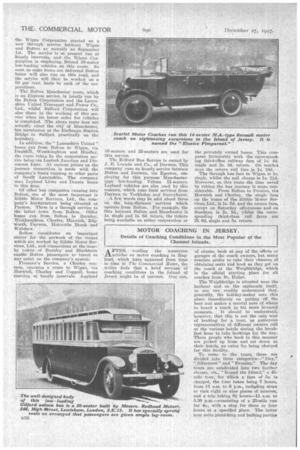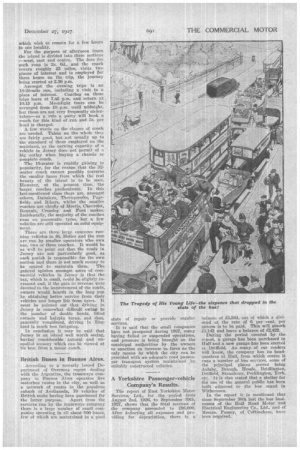MOTOR COACHING IN JERSEY.
Page 52

Page 53

If you've noticed an error in this article please click here to report it so we can fix it.
Details of Coaching Conditions in the Most Popular of the Channel Islands.
A PTER reading the numerdus articles on motor -coaching in England, which have appeared from time to time in The Commercial Motor, the writer feels that a brief account of coaching conditions in the (island of Jersey might be of interest. One can,
of course, book at any of the offices cr garages of the coach owners, but many tonrists prefer to take their chances of obtaining seats and book as they get on the coach at the Weighbridge, which is the official starting place for all coaches from St. Helier.
The Weighbridge is situated near the harbour and on the esplanade itself, so one can readily understand that, generally, the holiday-maker sees this place immediately on getting off the boat and makes a mental note of -where to board a coach in his more leisured moments. It should be understood, however, that this is not the only way of booking for a tour, as numerous representatives of different owners call at the various hotels during the breakfast hour to take bookings for the day. Those people who book in this manner are picked up from and set down at their hotels, no extra lee being charged for this facility.
To come to the tours, these are divided into three categories—" Day," " Afternoon " and "Evening." The day tours are subdivided into two further classes, viz., "Round the Island," a 45mile tour, for which a fare of 5s. is charged, the time taken being 7 hours, from -11 a.m. to 6 p.m., inclading stops to visit eight or nine places of interest, and a trip taking 6i hours-11 a.m. to 5.20 p.m.—consistingof a 25-mile run for 4s., with a stop for three or four hours at a specified place. The latter tour suits picnicking and bathing parties which wish to remain for a few hours in one locality. "
. For the purpose of afternoon tours the island is divided into three sections —west, east and centre. The fare for such runs is 25. Gd., and the coach covers roughly 25 miles, visits two places of interest and is employed for three hours on the trip, the journey being started at 2.30 p.m.
Amongst the evening trips is an 18-20-mile run, including a visit to a place of interest. Coaches on these trips leave at 7.45 p.m. and return at 10.15 p.m. Moonlight tours can be arranged from 10 p.m. until midnight, but these are not very frequently undertaken—as a rule a party will book a coach for this kind of run and 3s. per head is charged.
A few words on the classes of coach are needed. Taken on the whole they are fairly good, but not usually up to the standard of those employed on the mainland, as the earning capacity of a vehicle in Jersey does not permit of a big outlay when buying a chassis or complete coach.
The 16-seater is rapidly gaining in popularity, for the reason that the 32seater coach cannot possibly traverse the smaller lanes from which the real beauty of the island is to be seen. However, at the present time, the larger coaches predominate. In this last-mentioned class there are, amongst others, Daimlers, Thornycrofts, Pagefields and Bikers, whilst the smaller coaches tire chiefly of Morrie, Chevrolet, Renault, Crossley and Ford makes. Incidentally, the majority of the coaches runs on pneumatic tyres, but a few vehicles are still operated on solid equipment.
There are three large concerns running vehicles in St. Helier and the rest are run by smaller operators who own one, two or three coaches. It would be as well to point out that the roads in Jersey are not particularly good, as each parish is responsible for its own section and there is not much money to be spared to maintain them. The general opinion amongst users of commercial vehicles in Jersey is that the tax, which is small, could be slightly increased and, if the gain in revenue were devoted to the improvement of the roads, owners would benefit in the long run by obtaining better service from their vehicles and longer life from tyres. It most. be pointed out that driving in Jersey is somewhat difficult owing to the number of double bends, blind corners and hairpin turns, and that, generally considered, driving in England is much less fatiguing.
In conclusion it may be said that Jersey is an island well worth seeing, having' considerable natural and unspoiled scenery which can be viewed at Its best from a motor coach.
British Buses in Buenos Aires.
• According to a recently issued Department of Overseas report dealing with the Argentine, the tramways company in Buenos Aires operates five motorbus routes in the 'city, as well as a network of routes in the populous suburb of Avellaneda, 70 vehicles a British make having been purchased for the •latter purpose. Apart from the services run by the tramways company there is a large number of small companies operating in all about 500 buses, few of which are maintained in a good
state of repair or provide regular services.
It is said that thesmall companies have not prospered during 1927, many having failed or suspended operations, and pressure is being brought on the municipal authorities by the owners to sanction an increase in fares as the only means by which the city can be provided with an adequate road passenger transport system maintained by suitably constructed vehicles.
A Yorkshire Passenger-vehicle Company's Results. •
The report of East Yorkshire Motor Services,. Ltd., for the -period -from August 2nd, 1926, to September -30th, 1921', shows that the total revenue of the company amounted to £95,000. After deducting all expenses and providing for depreciation, •there is a balance of £5,564, out of which a dividend at the rate of 6 per cent. per annum is to be paid. This will absorb £3,142 and leave a balance of £2,422.
During the period covered by the report, a garage has been purchased in Hull and a new garage has been erected • at Driffield. As many of our readers will know, the company has its headquarters at Hull, from which centre it runs a number of bus services, some of the principal places served being Anlaby, Brough, Hessle, Bridlington, Drififield, Stoneferry, Pocklington, York, etc. " It is also stated. that a shelter for the use of the general public has been built adjacent to the bus stand in Withernsea.
-In the report it is mentioned that since September 30th last the bus businesses of the Hull Road Motor and Electrical Engineering Co., Ltd., and of Messrs. Fussey, of Coffin:than], have been acquired.


























































































